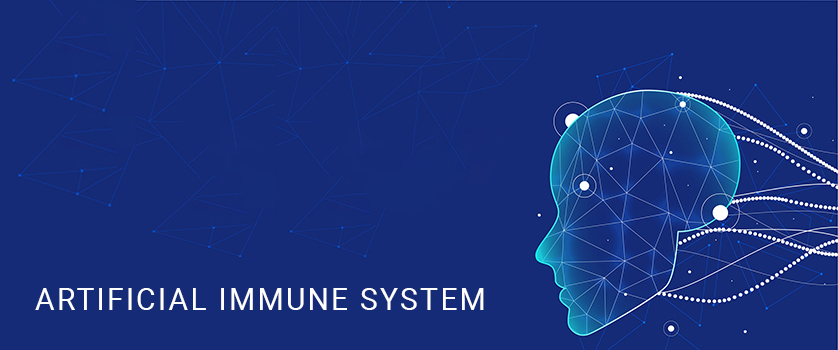
Anshul Jain
July 22, 2020
Ever since its introduction, Artificial Intelligence (AI) has given way to various new technologies that are working towards making machines more intelligent and helpful for human beings. From virtual agents to AI optimized hardware, today, one can find innumerable technologies powered by Artificial Intelligence and its various branches like machine learning, natural language processing, deep learning, etc.
One such field of artificial intelligence that is rapidly gaining popularity around the world and playing a critical role in various spheres of information technology is the Artificial Immune System (ASI). Inspired by the principles and processes of the natural immune system, this field of artificial intelligence attempts to take advantage of the benefits of the natural immune system and tackle complex problems in various domains. Since the ASI promises a more advanced future in technology, it is crucial that we understand its significance and scope.
So, let's begin.
What is the Artificial Immune System?
A subfield of biologically inspired computing and natural computation, Artificial Immune Systems AIS are adaptive systems that incorporates the properties of the theoretical immunology and observed immune functions, models, and principles, including distributed computation, error tolerance, dynamic learning, and self-monitoring, which are applied to problem-solving in fields like computer science, information technology, mathematics, etc. Moreover, it is a computationally intelligent and rule-based machine learning system that is focused on abstracting the structure of the vertebrate immune system to the computational system.
The field of AIS is relatively new, yet its popularity can be assessed with the increasing interest of researchers around the world. Ever since the first International Conference on Artificial Immune Systems (ICARIS) held at the University of Kent at Canterbury in 2002, the technology has already been applied to a wide range of application domains such as fault diagnosis, computer security, and virus detection and is drawing upon the work done by many theoretical immunologists.
Features of Artificial Immune System:
Unlike other fields of artificial intelligence, the objective of artificial immune systems is to simplify complex classifications and help machines and robots find a suitable solution through the most accurate and appropriate method. However, there are various other features that set this tech apart, such as:
- It is one of the two meta-heuristic techniques, which also includes Ant Colony Optimization.
- Uses neural networks to model the learning process.
- Helps solve benchmark problems in various fields like image processing, adaptive control system, data mining, anomaly or error diagnosis, etc.
- It is unlike computational immunology and theoretical biology.
- Used in modeling biological processes in computers and robots.
- It is applied in-immune algorithms to bioinformatics problems.
Now that we understand the basics of AIS, we should focus on comprehending how it works by unraveling its architecture.
Architecture for an Artificial Immune System:
The architecture of the artificial immune system is closely modeled on the mechanisms of the biological immune system and hence follows a similar process. These, like the immune system, consists of the following key components:
- Problem Definition: Like the immune system that distinguishes self from non-self based on proteins, AIS also addresses a similar problem by distinguishing or classifying a task into either normal (self) or anomalous (non-self). However, this can result in two kinds of discrimination errors, which are to be minimized by AIS:
- False Positive: This occurs when the self string is termed anomalous.
- False Negative: This occurs when the non-self string is termed normal.
- Detectors: AIS uses various mobile detectors present in a distributed environment. However, these only interact with other detectors at the same vertex. The detectors are connected with a binary string that represents receptors, which are bound to epitopes. As detectors are responsible for distinguishing between self and non-self, they are required to match with a certain number of detectors within a specified time, which is termed as an activation threshold.
- Training the Detection System: To detect anomalies, AIS uses the distributed form of negative selection algorithm, which is based on the negative selection that takes place in the immune system.
- Memory: AIS relies on memory-based detection, that mimics the immune response seen in the immune system, to offer a rapid and efficient secondary response. This involves a competition of various detectors at the node. Moreover, the lower the activation threshold of the memory detectors the better and more rapid the response is.
- Sensitivity: The next step of the architecture is the sensitivity, which is the result of the detection event. These are responsible for transferring and signaling the response from memory detectors to the nearby receptors.
- Co-stimulation: To ensure detectors match every string, a stimulation is implemented by a human operator to provide a second signal, which helps differentiate between self and non-self.
- Detector Lifecycle: Next in the AIS architecture we come to the detector lifecycle. During the process of encoding information and patterns, memory detectors are the only detectors that don't expire over time. However, since all detectors can eventually become memory detectors, they can create a dynamic detector population. Therefore, to avoid such a scenario, a limit is set on a fraction of memory detectors. When this limit is reached, the least recently used detectors are filtered and termed mature. This activated and matured detector only expires if it does not receive co-stimulation.
- Representations: Each of the detection nodes in Artificial Immune Systems relies on different representations to filter incoming strings. This is accomplished through a randomly generated permutation.
- Response: Finally, it uses various effector selection to deliver appropriate responses, with the help of migrating detectors that carry information regarding the patterns of anomalies as well as ways to eliminate them.
Artificial Immune System Algorithms:
The Artificial Immune Systems, a new computational intelligence approach, uses a variety of algorithms to detect anomalies in a set of strings. Each of these is responsible for different functions of anomalies detection. The most commonly used AIS algorithm are:
- Negative Selection Algorithm: A key algorithm of the artificial immune system for classification, the negative selection algorithm is inspired by self-non-self discrimination behavior observed in the immune system. It is commonly used for problem classification and pattern recognition. Negative Selection creates a set of detectors, which includes self-strings only, that are further used for anomaly detection. This type of artificial immune algorithms involves two major steps:
- Censoring: Here, self-strings are matched with randomly generated strings, which if matched are rejected and if not are moved to the detector set.
- Identify Nonself: The objective here is to match protected strings with the detector set to identify the non-self.
- Artificial Immune Networks (aiNet): Another important and intelligent algorithm for artificial immune systems, the Artificial Immune Networks algorithm or aiNet learning algorithm is inspired by the Immune Network theory of the acquired immune system. Moreover, it consists of the Optimization Artificial Immune Network algorithm, which is the base version and the extension for optimization problems. Currently, aiNet has been successfully applied to a vast array of engineering areas including data mining, pattern recognition, optimization, time series prediction, fault detection, computer security, process control, and more.
- Clonal Selection Algorithm: Clonal Selection Algorithms, which is also known as CSA or CLONGALG is an AIS algorithm inspired by the elements of the clonal selection theory of acquired immunity, like generation and maintenance of diversity, maintenance of memory set, affinity maturation, etc. The algorithm is most commonly used in areas such as optimization and pattern recognition and is focused on the Darwinian attributes of the theory. Moreover, like negative selection algorithms, CSA also follows certain steps:
- Initialization: Prepares an antibody pool of fixed size, which is divided into two components, a memory antibody section and a remaining antibody pool, which is further used to introduce additional diversity into the system.
- Loop: After initialization, the algorithm then executes a number of iterations, which follows a process that includes:
- Select Antigen
- Exposure
- Selection
- Cloning
- Affinity Maturation
- Clone Exposure
- Candidature
- Replacement
- Finish: Finally, once the process is completed the memory component of the antigen pool is considered as the final solution.
- Danger Theory and Dendritic Cell Algorithms: The last type of AIS algorithm, which also belongs to Computational Intelligence, Dendritic Cell Algorithms, like the earlier algorithms, in mammalian immune inspired. Moreover, it stimulates the Danger Theory of the immune system, especially the role of dendritic cells. Furthermore, it is abstracted and implemented through a process of examining and modeling various aspects of DC function. Dendritic Cell Algorithm is not specifically a classification algorithm but is considered a data filtering method used in anomaly detection problems.
Apart from these algorithms, Hybrid heuristic-based artificial immune systems is another important algorithm that is being used by AI experts for solving problems and task scheduling.
Now that we have covered AIS algorithms, let us move on to the major concepts of the artificial immune system and the role they play in making this tech efficient and capable of being effective.
Concepts of Artificial Immune System:
The implementation of artificial immune systems is made possible by four important concepts, encoding, similarity measure, selection, and mutation. It is through these decisions that AIS can be successfully implemented and be used to reach the desired or most accurate solutions. It is these four concepts that are defined in details below:
- Initialization or Encoding: Initialization or encoding are among the most critical heuristics considered during the implementation of the Artificial Immune System. It helps encode and represent antigens and antibodies in the form of strings of numbers or features.
- Similarity or Affinity Measures: Another important concept that plays a key role in designing and developing the artificial immune system is the similarity measure or matching rule. It is closely coupled with initialization or encoding and helps find the correlations between the detectors. These matching detectors are eliminated and the non-matching detectors will form the detector set, which will be used in the later stages of the algorithm.
- Negative, Clonal, or Neighbourhood Selection: The third element of that helps with the implementation of AIS is negative, clonal, or neighborhood selection, based on the problem it is applied to. Selecting for one of these suitable recommenders is crucial as it helps perform a positive selection.
- Somatic Hypermutation: Finally, somatic hypermutation is used by AIS, which is similar to the mutation that takes place in the genetic algorithms. It helps mutate the data sensibly to allow artificial entities to represent plausible data. However, as mutating data is not suitable for all types of problems, this technique is not popularly used during AIS implementation.
Applications of Artificial Immune System:
The introduction of artificial immune systems has not only been beneficial for the field of computer science and artificial intelligence but also for various other industries, as they are currently using the tech to further improve processes and simplify problem-solving. Therefore, listed here are some of the applications and advantages of artificial immune systems.
- Computer Security: The area where AIS is being used predominantly is in enhancing computer security. One such example of the application of AIS in computer security is the work of Stephanie Forrest. She, along with her group at the University of New Mexico, is working to create artificial immune system cybersecurity for computers that is capable of detecting viruses, maintaining the integrity of files, detecting unauthorized use of the computer, etc. with the help of negative selection algorithm.
- Anomaly Detection: Anomaly detection is another important area where the scope of Artificial Immune System is increasing tremendously. Currently, the tech is used to identify anomalies and faulty patterns, with the help of the detectors, which rely on accumulated data, that can capture the semantics of the data patterns, to identify anomalies. From computational security and negative selection to image inspection, time-series novelty detection, image segmentation, etc. are all using AIS for anomaly detection.
- Pattern Recognition: With the increasing importance of AIS, it is no wonder the technology is being used in the fields to improve pattern recognition. From generic approaches and spectra recognition, the artificial immune system is offering great potential and is hence being utilized in areas such as DNA sequences, and more
- Robotics: As the objective of the artificial immune system is to simulate the biological immune system into machines and robots, it is excessively being used in the robotics industry for behavior arbitration mechanisms and the emergence of collective behavior.
- Optimization: Organizations worldwide are using AIS for solving optimization problems. Be it unconstrained or constrained problems, multimodal or multi-objective problems, AIS is successfully resolving them with the help of its numerous algorithms and offering machines the capability to reach the most accurate solutions.
- Fault Diagnosis: Another prominent area that is using AIS is the field of fault diagnosis. The technology is helping organizations develop adaptable fault-tolerant systems, wherein error detectors may evolve during runtime. Moreover, AIS helps increase the availability of embedded systems, which further makes the process more beneficial.
Even though the artificial immune system is new to the field, its adaption within industries is happening at a drastic speed and is predicted to increase in the upcoming years.
Conclusion:
With the ever-advancing field of computer science and information technology, there is no wonder that new and more innovative technologies are being developed around the world. Researchers are working tirelessly to bring in new algorithms, methodologies, and technologies like Artificial Immune System, Swarn Intelligence, Computational Intelligence, and more to further enhance the capabilities of machines and make them more efficient as well as like humans. Considering this demand, this innovation is bound to increase until it achieves superintelligence.




